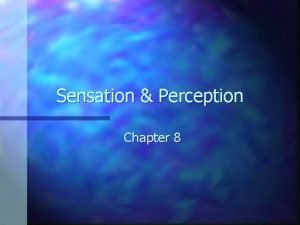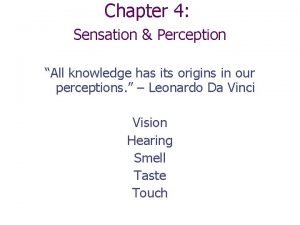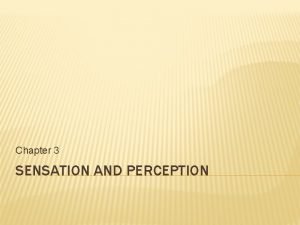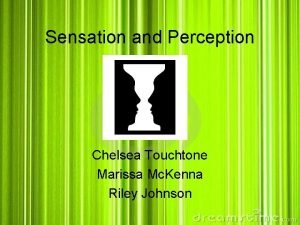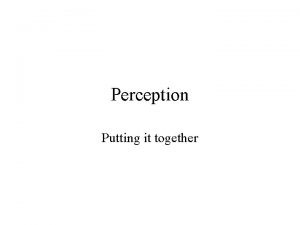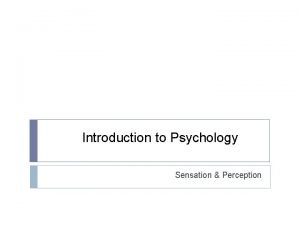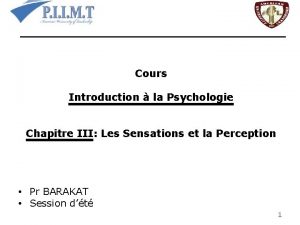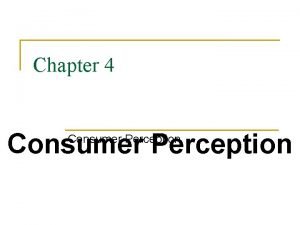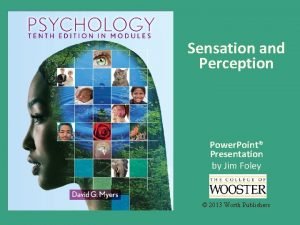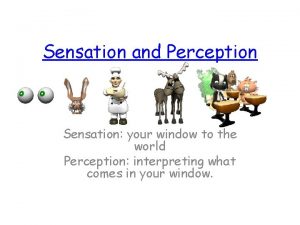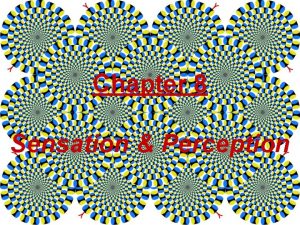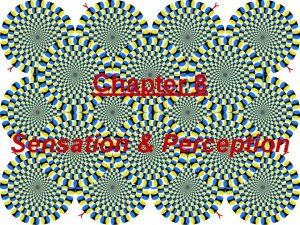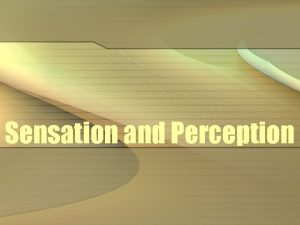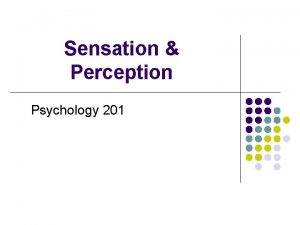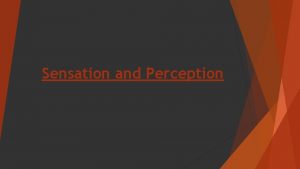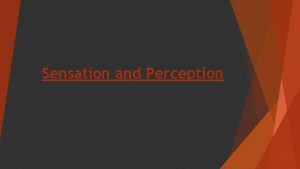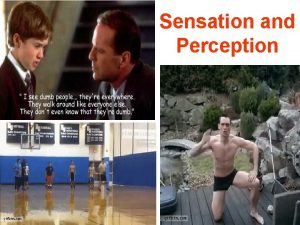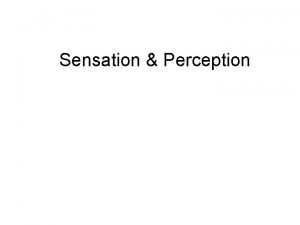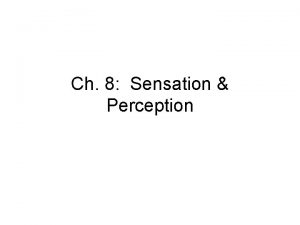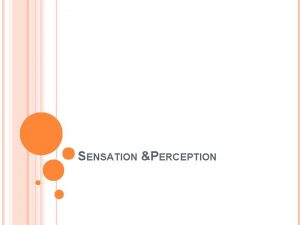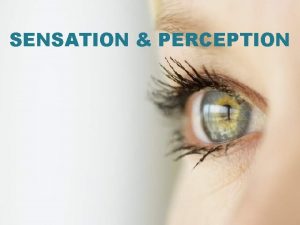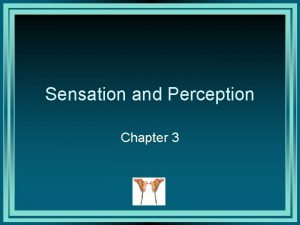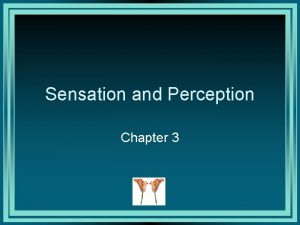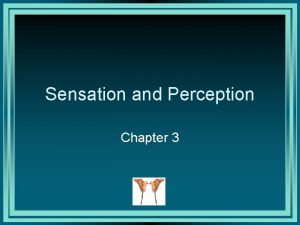CHAPTER 4 SENSATION PERCEPTION SENSATION PERCEPTION v Sensation

















- Slides: 17

CHAPTER 4 SENSATION & PERCEPTION

SENSATION & PERCEPTION v Sensation: The process of receiving stimulus energies from the external environment and transforming those energies into neural impulses. Ø How energy from the world is transformed into neural impulses that our brain can understand. Ø Activation of the senses v Perception: The process of organizing and interpreting sensory information so that it has meaning. Ø How our brain selects, organizes, and interprets sensory input. Ø Understanding sensations

BOTTOM-UP PROCESSING v. Sensory receptors register information about the external environment and send it up to the brain for interpretation. ØA progression from the individual elements to the whole. ØIncoming sensory messages v. Sensation > Perception v. More accurate, slower v. Example: ØFeature analysis

TOP-DOWN PROCESSING v. Launched by cognitive processing at the brain’s higher levels, that allows the organism to sense what is happening and to apply the framework to the information from the world. Ø A progression from the whole to the individual elements. Ø Brain’s effort to make sense of incoming messages v. Perception > Sensation v. Faster, error prone v. Example: ØGestalt principles ØPerceptual set


PSYCHOPHYSICS v. The study of how physical stimuli are translated into psychological experiences. Physical World (Sensation) Psychological World (Perception) Light Brightness Sound Volume Pressure Weight

TRANSDUCTION v. The transformation of stimulus energy into neural impulses that the brain can interpret. SENSATION PERCEPTION TRANSDUCTION

SENSORY RECEPTORS v. Specialized cells that detect stimulus information and transmit it to sensory (afferent) nerves and the brain. v. Main classes of receptors based on the type of energy that is detected: 1. Photoreceptors: detection of light; perceived as sight (eyes) 2. Mechanoreceptors: detection of pressure and vibration; perceived as touch and hearing (skin, ears) 3. Chemoreceptors: detection of chemical stimuli; perceived as smell and taste (nose, tongue) 4. Thermoreceptors: detection of temperature;

SYNESTHESIA v. An experience in which one sense (sensation) induces an experience (perception) in another sense. ØExamples: § “see” music § “taste” colors

THRESHOLDS Absolute Threshold Difference Threshold v. The minimum amount of stimulus energy that a person can detect 50% of the time. v. The smallest degree of difference that must exist between 2 stimuli before the difference is detected. v. Also called just noticeable difference (JND) Ø Examples: § Vision: candle flame at 30 miles on a dark, clear night § Hearing: ticking clock at 20 feet under quiet conditions § Touch: wing of a fly falling on your neck from 1 centimeter § Taste: 1 teaspoon of sugar in 2 gallons of water § Smell: 1 drop of perfume diffused throughout 3 rooms Ø Examples: § You change the temperature from 74 degrees to 73 degrees, and all of a sudden someone in the house is cold. § You change the volume of the car by one level and someone complains that it is too loud.

JUST NOTICEABLE DIFFERNCE Weber’s law Fechner’s Law v. Ernst Weber v. The size of a JND must be a constant percentage of the size of the initial stimulus to perceive the difference. v. Gustav Fechner v. The magnitude of a sensory experience is proportional to the number of JNDs that the stimulus is above absolute threshold. Constant minimum percentage Ø Example: § Light-8% § Weight-2% § Tone-. 3% Ø Ø Scaling Ø Example: § § You walk into a dark room 1 st lamp- difference is HUGE 2 nd lamp- twice the light, but not twice as bright 3 rd lamp- barely notice difference

SUBLIMINAL PERCEPTION v. The detection of information below the level of conscious awareness. ØOccurs below absolute threshold ØMay influence behavior (slightly effective)

SIGNAL DETECTION THEORY v. Theory of perception that focuses on decision making about stimuli in the presence of uncertainty. v Ability to discriminate between noises Ø Noise: Irrelevant and competing/distracting stimuli for our senses. v Detection depends on: Ø Fatigue Ø Expectation (high vs. low) Ø Motivation/Urgency Ø Experience

SIGNAL DETECTION THEORY (False negative) (False positive)

ATTENTION v. The process of focusing awareness. Ø Selective attention: The process of focusing on a specific aspect of the environment while ignoring others. § Cocktail party effect: The ability to concentrate on one voice among many in a crowded room. • Example of selective attention § Stroop effect: Automatically reading the color’s name instead of the ink color. • Failure of selective attention Ø Certain stimuli attract attention: § Novel, large, vivid, moving, emotional Ø Perceptual Blindness: § Emotional-induced blindness § Inattentional blindness § Change blindness

PERCEPTUAL SET v. A predisposition or readiness to perceive something in a particular way. ØThe brain learns to perceive through experience ØExpectations influence perceptions ØTop-down influence

SENSORY ADAPTATION v. A change in the responsiveness of the sensory system based on the average level of surrounding stimulation. ØA gradual decline in sensitivity to prolonged stimulation. v. Examples: ØLight Adaptation ØDark Adaptation ØWatch on your wrist ØOdor in a room
 Chapter 5 sensation and perception
Chapter 5 sensation and perception Chapter 3 sensation and perception
Chapter 3 sensation and perception Chapter 6 sensation and perception
Chapter 6 sensation and perception Copyright
Copyright Kinesthetic sense
Kinesthetic sense Sensation perception
Sensation perception Chapter 4 sensation and perception
Chapter 4 sensation and perception What is sensation
What is sensation Gestalt figure ground tessellation
Gestalt figure ground tessellation Ap psych sensation and perception
Ap psych sensation and perception What are sensations
What are sensations Sensation and perception crossword review answers
Sensation and perception crossword review answers Perceptual system
Perceptual system Sensation and perception
Sensation and perception Exposé sur la sensation en psychologie
Exposé sur la sensation en psychologie Levels of perception
Levels of perception Perception vs sensation
Perception vs sensation Sensation and perception
Sensation and perception





